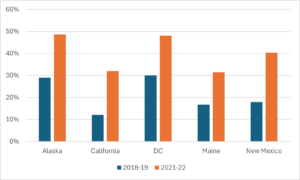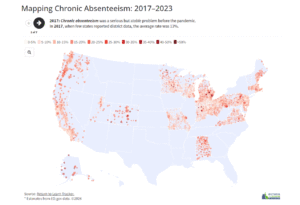Beyond Interventions: Building Relationships that Help Get Kids to School
What the Data on Chronic Absence Is Really Saying
Since the pandemic closed schools four years ago, our nation’s school districts have struggled to recover on several fronts, from enrollment and learning setbacks to school climate issues and social-emotional development. Perhaps no issue, however, has been as stubborn, persistent—and pervasive— as the dramatic increases we’re witnessing in chronic absenteeism. It’s a challenge that cuts across geography and demographics and has continued long after schools reopened and returned to “normal.”
Perhaps just as pervasive is the prevailing mindset that with just the right intervention(s) we can dig our way out of the problem. We propose that unrelenting chronic absenteeism is symptomatic of a much bigger foundational issue at play: trust. And although there is an important role that various interventions play in making schools more effective, no amount of door-knocking, text messaging, and campaigns—positive or punitive—will permanently abate those numbers. It is true that interventions are essential to support the success of some students, but when attendance data show wide swaths of students are missing school, schools need to re-evaluate their approaches.
It’s time for school districts to take an honest assessment of their communities’ faith in the school system and the impediments preventing families from seeing schools as trusted partners in their children’s development. Crucially, school districts need a sobering review in their own faith in the families they serve and a careful appreciation of precisely what prevents them from seeing families as trusted partners.
The Problem, Defined
A student is chronically absent when they’ve missed at least 10 percent of school days in a year. All absences—excused, unexcused, and suspensions—count toward measuring chronic absence. Many school districts faced serious chronic absenteeism long before the pandemic, but that singular disruption led to sharp, record-breaking increases with which nearly every district in the nation is still contending.
Figure - Sample of Data on State Chronic Absenteeism Rates by School Year

DATA SOURCE: FUTURED
For example, in a sampling of data compiled by FutureEd, we can see chronic absence rates in Alaska went from 29 percent pre-pandemic to 48.6 percent during the 2021-22 school year. That’s an unprecedented 68 percent hike. California’s rate nearly tripled from 12.1 percent to 32 percent. DC’s pre-pandemic high of 30 percent rose to 48.1 percent. Hawai’i climbed 14.7 percent to 36.9 percent; Maine 16.7 percent to 31.5 percent; and New Mexico 17.9 percent to 40.4 percent.
Some states have seen a modest positive shift in chronic absenteeism rates, but almost no state is close to their pre-pandemic levels. The Return 2 Learn Tracker, hosted by the American Enterprise Institute, shows the numbers in stark detail, geographically displaying the worsening of chronic absence rates nationwide between 2017 and 2023.

SOURCE: AMERICAN ENTERPRISE INSTITUTE
Chronic absence keeps kids from receiving the consistent instruction they need to build on basic skills. They risk falling behind and failing courses and exams. They miss out on interactions with peers and play a constant game of catch-up. They are less likely to be on grade level in reading and math. They lose opportunities for meals, counseling, and on-time graduation. Being out of school also means teachers must contend with continuity in lesson planning. Moreover, attendance affects many districts’ bottom line, as part of their funding formula relies on average daily attendance or a similar count.
A Culture of Attendance
Recognizing the complexity of reasons for today’s chronic absence problem, the White House and U.S. Department of Education have announced historic investments to help schools fight chronic absence and create a “Culture of Attendance.” These investments include targeted federal grant programs, tools for data analysis to identify absenteeism trends, and resources for supporting students’ basic needs to improve attendance (such as through support of full-service community schools).
The announcement comes on the heels of a May 2024 gathering of leaders—governors, superintendents, policymakers, advocates, parents, and students—at the White House. There, leaders discussed the strategies and interventions they’ve investigated and used to combat chronic absenteeism. These include using personalized text messages to nudge students to attend school, conducting door-knocking campaigns, launching public relations campaigns to enhance community connection with parents and families, and increasing transportation options. Some representatives spoke of their partnerships with their state District Attorneys Association and other law enforcement agencies to call parents and public housing authorities to encourage attendance among their residents.
A Missed Opportunity
The meeting also aptly emphasized the importance of using high-quality data to track the problem of chronic absence, a familiar refrain for school districts, which are rightly accustomed to seeking evidence for the policies and practices they implement. However, going straight from monitoring metrics to implementing an intervention neglects that every data point represents a person, with a life full of dimension, nuance, and history. We would all do well to understand the human stories behind the numbers. Chronic absenteeism often results from underlying issues such as housing or food insecurity, transportation problems, social or emotional struggles, and a host of other challenges. It may also be a result of a lack of meaningful connection to the learning environment. Therefore, a critical next step is to create opportunities to build trust and a sense of belonging. Jumping from data to intervention can reduce the tether students have to school. Students should always see the relevance of their education or have a connection to a caring adult in the school. When these foundational measures are in place, there’s a greater chance of students showing up and getting engaged in learning.
A clear reading of chronic absence data through the lens of trust and belonging raises questions about whether anyone can “intervene” their way out of a chronic absence problem. In fact, the absenteeism rates are pointing to bigger, systemic issues within the school. These high levels of student absences demonstrate that we should focus on a much more universal, foundational change in the way we do school. These times call for fundamental practices that bolster a sense of belonging for all students.
These data are a clarion call to think more deeply about school culture and climate and the conditions that support strong student engagement.
The link between families and getting students to school is nearly inextricable. It is in the exploration of this link that schools might begin to find their way back. Parents, caregivers and students should never feel they are just another person in an impersonal institution that fails to see their humanity and show care. That’s what our founder Yesenia Ramirez faced when she went to her school to get help for her daughter’s reading. She sat for hours unacknowledged and left in frustration. She and the community of people who began our organization knew there was a profound lack of trust in both directions—of teachers by parents and of parents by teachers.
School staff had made sweeping generalizations about why the children weren’t doing well in school, and why their parents weren’t more involved. Parents thought teachers didn’t care. They were both wrong, and it took a meeting of minds, frank and courageous conversations to surface these issues, which are so often secretly harbored. What eventually paved the way for the school to improve its data—test scores, chronic absence, and other issues—was instituting a culture-changing practice of home visits.
We didn’t invent the concept of home visits. We developed a unique model of home visits whose purpose is to build trusting relationships between educators and families. The PTHV model honors both parties’ time and comfort by making visits voluntary. We train teachers and ensure they are compensated. They talk with families about their hopes, dreams, and goals for their students. We likewise insist that teachers visit a cross-section of students or all students where possible, rather than target students (such as those who are chronically absent) because the goal is to foster mutual trust and respect among participants. In addition, our model calls for educators to go in pairs and reflect on what they learned about families and students, and themselves, during their visits. We see this reflection turn up in classroom instruction, and this often leads to systemic cultural change within the school, even among students who do not receive home visits.
Parent Teacher Home Visits are a practice, not an intervention, though rigorous research shows that this practice provides the fertile ground on which academic achievement and improved attendance grow. What happens is not magic, and ours is not a turnkey solution that school administrators can install to check chronic absence off their list. It is an approach to relationship-building, to creating safe spaces and level playing fields for schools and communities to talk face-to-face about what they want for their students. Teachers gain a deeper understanding of students’ lives, and families feel valued and supported by the school community. This two-way partnership gives way to tailored solutions, leveraging specific strengths and addressing specific challenges rather than forcing a one-size-fits-all approach.
Building trusting relationships is the most effective tool schools have, and when it starts on the front end at the beginning of the year rather than as a response to a problem, it is one that pays big dividends all year long.

